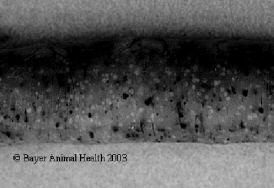ThePoultrySite Quick Disease Guide
Contents of Quick Disease Guide
Coccidiosis, Mid-intestinal, E necatrix
|
Extracted From:
A Pocket Guide to Poultry Health and Disease |
 |
Introduction
A highly pathogenic form of coccidiosis, caused by Eimeria necatrix, in which the parasite is present in the small intestine and in the caecum. It occurs in chickens worldwide and has variable morbidity but mortality is high in severely affected birds.
Signs
- Reduced feed consumption.
- Depression.
- Ruffled feathers.
- Closed eyes.
- Inappetance.
- Poor production.
- Diarrhoea, blood in faeces.
Post-mortem lesions
- Petechiae and thickening, of middle to posterior third or more of small intestine.
- 'Sausage-like' intestine.
- Severe necrotising enteritis.
- Schizonts seen as white spots through the serosa interspersed with petechiae. Deep scrapings necessary to show large schizonts. Oocyts in caecal scrapings.
Diagnosis
Signs, lesions, microscopic examination of scrapings Differentiate from necrotic enteritis, other types of coccidiosis.
Treatment
Toltrazuril, Sulphonamides, Amprolium, Vitamins A and K in feed or water.
Prevention
Coccidiostats in feed, vaccination, hygiene. This is one of the less immunogenic species, commercial vaccines commonly contain more than one strain of E. maxima.
 |
| Figure 14. Moderate Eimeria necatrix infection in the jejunum of a chicken (Score 3). In this case the intestine is thickened and can become ballooned and sausage-like. Haemorrhages and white spots are visible from the outside of the intestine. |


 © 2000 - 2021. Global Ag MediaNinguna parte de este sitio puede ser reproducida sin previa autorización.
© 2000 - 2021. Global Ag MediaNinguna parte de este sitio puede ser reproducida sin previa autorización.